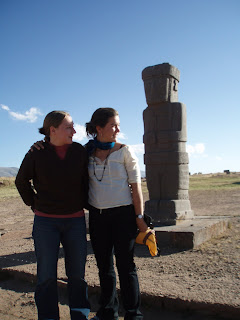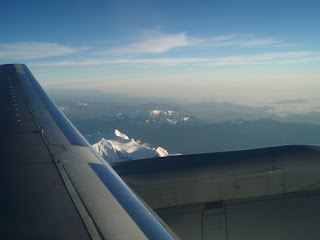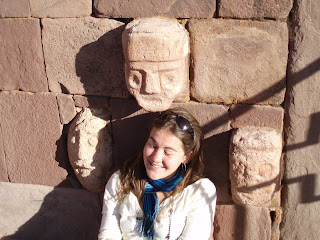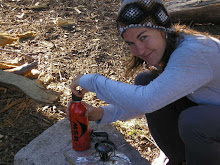Wednesday, June 13, 2007
Reunion in the Ruins
Machu Picchu
 Just before sunrise, 6:30 AM
Just before sunrise, 6:30 AM At the top of Wayna Picchu, young mountain in Quechua, 8:00 AM. The ruins are below. This is a real photo, I swear.
At the top of Wayna Picchu, young mountain in Quechua, 8:00 AM. The ruins are below. This is a real photo, I swear. Templo de la Luna, a cave that yes, is full of Inca ruins.
Templo de la Luna, a cave that yes, is full of Inca ruins. It was a long way up, a long way down, and we had much much more up to go...
It was a long way up, a long way down, and we had much much more up to go...
When we were at Muchu Picchu there was a campaign going on in support of naming Machu Picchu one of the new "Wonders of the World." I didn't sign because it seems to me that more important than its status is protecting the site from the environmental and human impacts that hit it hard. There is talk of reconstructing the roofs of the buildings. If anyone has any info on what the impacts of this would be, lemme know.
Communing with the Apus
 At the Choquequiroa ruins
At the Choquequiroa ruins Llamas embedded into the terraces thought to have been constructed after the Spanish arrived when the Incas took refuge here in Choquequirao. They were excavated and opened for viewing only very recently. Our guide Maria had been to Choquequirao more than 20 times and it was her first time seeing these llamitas.
Llamas embedded into the terraces thought to have been constructed after the Spanish arrived when the Incas took refuge here in Choquequirao. They were excavated and opened for viewing only very recently. Our guide Maria had been to Choquequirao more than 20 times and it was her first time seeing these llamitas.Upon the last steps of our trek in Cachora, before we head for lunch and chicha.
We finished the Choquequirao trek four days before Ethan Todras-Whitehill unveiled it to the world in the New York Times Travel section (see link below). Instead of the traditional start-finish in Cachora, we started off in Huanipaca in order to do a round circuit. We were seven: our fabulous guide Maria, at 26 one of the smartest and toughest women I know, Eber our cook, his friend and assistant Genaro, and the crew of us chicas locas, Erin, Anna, Margaret and I. Margaret is my friend from college--we realized on the trek that we have been friends for 7 years, Anna is my rockus little sister, and Erin her totally hysterical and chill friend. Turns out there is someone in the world besides my friend Karl who eats faster than me, it's Erin.
No matter where you start, it is a two day hike deep into the mountains to reach the ruins of Choquequirao. Though far smaller of a site than Machu Picchu, Choquequirao is thought to have been a cultural and religious center of equal importance. Upon the arrival of the Spanish, the Inca nobles and priests abandoned Machu Picchu so that the Spanish would not find it (that is likely why it was not destroyed or irreparably damaged) and retreated to Choquequirao, possibly in order to secure access to Vilcabamba, another important Inca center.
We spent our whole third day exploring the ruins, the morning in the ruins of the terraces below our campsite and the afternoon in the ruins of the temples, homes, and ceremonial center at the tops of the mountains above. The first time you come, the apus (gods of the mountains) allow you to make one wish with the offering of three coca leaves. When two massive condors flew right by our noses, the magic felt very real. Apart from a couple other tourists who we saw from afar and the keeper of the sign-in log, we were the only people around. As the sun set over the massive 6,000-plus-meter mountains in the far distance, I understood the power of the forces that the Incas had worshipped. I spoke with the apus. Whether they heard me or not I don't know, but I felt a deep sense of appreciation for the opportunity to see this wonder of the world. I hope that the plans underway to generate more tourism to this place do not rob it of its magic. The apus would not be pleased.
The La Paz of Old
 Tiwanaku, the site of the ruins of the culture by the same name that rose around 200-400 C.E. and fell 600-800 years later. Tiwanaku is believed to have been the administrative and religious center of an empire that extended throughout the central Andean region. Evo Morales, Bolivia's first indigenous president, was inaugurated here in January 2006.
Tiwanaku, the site of the ruins of the culture by the same name that rose around 200-400 C.E. and fell 600-800 years later. Tiwanaku is believed to have been the administrative and religious center of an empire that extended throughout the central Andean region. Evo Morales, Bolivia's first indigenous president, was inaugurated here in January 2006.
Incallajta
 With my good friend Saul standing on the ruins of Incallajta. We found out you're not supposed to do that--stand on the ruins--oopps! Llajta in Quechua means pueblo, and inca of course refers to the Incas. This place was an Inca outpost in the early 16th century to keep the unruly natives in line. Although Quechua is the language of the Cochabamba valley, the Quechuas are relatively recent arrivals to what is now Bolivia, sent by the Incas from Cuzco who were themselves Quechuas to populate Kollasuyo, the part of their empire that is now Bolivia. This is the origin of the term kollas that cambas (people from Bolivia's eastern department of Santa Cruz) use to refer to Bolivians from the altiplano, Bolivia's high western plains. Cochalos, people from Cochabamba, refer affectionately to their city as la Llajta, one of many examples of everyday use of quechua words by Spanish speakers.
With my good friend Saul standing on the ruins of Incallajta. We found out you're not supposed to do that--stand on the ruins--oopps! Llajta in Quechua means pueblo, and inca of course refers to the Incas. This place was an Inca outpost in the early 16th century to keep the unruly natives in line. Although Quechua is the language of the Cochabamba valley, the Quechuas are relatively recent arrivals to what is now Bolivia, sent by the Incas from Cuzco who were themselves Quechuas to populate Kollasuyo, the part of their empire that is now Bolivia. This is the origin of the term kollas that cambas (people from Bolivia's eastern department of Santa Cruz) use to refer to Bolivians from the altiplano, Bolivia's high western plains. Cochalos, people from Cochabamba, refer affectionately to their city as la Llajta, one of many examples of everyday use of quechua words by Spanish speakers.Primero de Mayo
 Cirilo Jimenez, the leader of the rentistas mineros, the retired miners, marches with his compañeros on May Day, 2007. Their signs called for full nationalization of Bolivia's mines and increased rentas, pension payments, from the government. The miners currently recieve about $150 per month.
Cirilo Jimenez, the leader of the rentistas mineros, the retired miners, marches with his compañeros on May Day, 2007. Their signs called for full nationalization of Bolivia's mines and increased rentas, pension payments, from the government. The miners currently recieve about $150 per month. The Joventud Comunista de Bolivia, the youth group of Bolivia's Communist Party, march on May Day.
The Joventud Comunista de Bolivia, the youth group of Bolivia's Communist Party, march on May Day.
The inauguration of the monumento al minero on May Day in the Max Fernandez neighborhood of Chilimarca, a community about 20 minutes north of Cochabamba's city center. The neighborhood used to be called Siglo XX, as it started out as a cooperative that miners from the mining center by the same name bought into. When more than 25,000 miners were "relocalized" in the mid-1980s, these miners were more fortunate than most to have a lot in Cochabamba to come to. Many lived in tents on their lots until they had the funds to construct a home. This monument is a replica of the monumento al minero in Siglo XX (see earlier blog entry "Siglo XX" below).
Fortunately the history of May Day has not been erased in Bolivia as it has almost been in the United States. Everyone from militant trade unionists to school children can tell you about the Haymarket martyrs in Chicago. My ex-miner friends were surprised to hear that here in the U.S. we not only do not learn about May Day, but that it has not been celebrated as the day of the worker for many years. They were happy to hear, however, about last year's immigrant rights demonstrations that brought May Day back to life in the place or its origin.
Gaucho Land
 The Bolivian-Argentine border at Aguas Blancas, three hours outside of the city of Tarija. No triple fences or snipers in helicopters here. On the way back in we had to go to great lengths to find the immigration office and convince the officer that we did indeed need our passports stamped.
The Bolivian-Argentine border at Aguas Blancas, three hours outside of the city of Tarija. No triple fences or snipers in helicopters here. On the way back in we had to go to great lengths to find the immigration office and convince the officer that we did indeed need our passports stamped. Las madres de la Plaza de Mayo. The mothers of the disappeared who continue to march every Thursday to demand justice for their children.
Las madres de la Plaza de Mayo. The mothers of the disappeared who continue to march every Thursday to demand justice for their children. Riding horses in the countryside outside of Tarija, Bolivia with my friends Nicky and Katja.
Riding horses in the countryside outside of Tarija, Bolivia with my friends Nicky and Katja.At the end of March I hit the road for Buenos Aires to meet up with two friends, Nicky and Chandra, and check out gaucho country. The flight to Tarija in southeastern Bolivia was a quick 45 minutes, the bus from there to BA was 30 hours each way. We saw everything from street art to the Eva Peron Museum, and I saw my first milonga, a performance of the Tango. The tango wasn't always universally loved in Argentina. Tango originally referred to a meeting place where freed and working slaves came together to dance in the early 19th century, and evolved to reflect the changing ethnic composition of porteño (Buenos Aires) society. Tango incorporates African rhythms brought by enslaved Africans (who made up 30% of the porteño population in 1778) and Spanish and Italian melodies introduced by immigrants recruited to replace the indigenous population that was systematically pushed out of Buenos Aires. It is said that indigenous men brought the dance to the slaughter house district of Buenos Aires, where it began to be danced in poor dance houses, bars, and brothels, and where milonga music (fast-paced polka) was incorporated.
We also got to go to a protest (in defense of community art centers the city government was trying to close) and check out the worker-operated Hotel Bauen. Then Nicky and I headed back to Bolivia to meet Katja in Tarija, the sleepy capital city of the department by the same name where much of Bolivia's natural gas is found.
Monday, June 11, 2007
Cochabamba Against the War



My ISO comrade Karl, Mauge, Boris, and Marcelo from the Fundacion Abril (above), some other folks, and I organized a protest against the War in Iraq the day before the war's fourth anniversary on March 16th, 2007. The Fundacion Abril is the organization that grew out of the Coordinadora de Agua y Vida that coordinated the massive protests in Cochabamba' s 2000 Water War against Aguas del Tunari, connected to the U.S. corporation Bechtel, that had been granted a contract to administer Cochabamba's water. Dozens or maybe even a few hundred people checked out the information we posted over the course of the day and were happy to hear from us in the speak-out that there is a resistance movement growing in the U.S., among soldiers, and among the Iraqis themselves.
Carnaval en Oruro


The Carnaval celebration in Oruro, the most important and elaborate in all of Bolivia, is danced in honor of the Virgin del Sacavon, or the Virgin of the Mining Shaft. The department of Oruro is home to many of Bolivia's most important mines, and the city by the same name has historically been the center of the processing and distribution of mined minerals. Carnaval for the Catholics marks the end of the period between Christmas and the beginning of Lent. In Mideval times, the Church claimed that Carnaval referred to the latin carne-levare, meaning abandon meat. Later arose the meaning now popularly ascribed to, that Carnaval comes from the italian carnevale meaning meat counts, or is okay. At the end of the 20th century, it began to be suspected that the name had pagan roots, from both the Celtics and the Indoeuropeans. Carna is the Celtic god of beans and pork, and Karna is a god from the Mahabharata, one of the two major Sanskrit epics of ancient India, the other being the Ramayana. Some believe that the word carnaval makes reference to an ancient pagan tradition of offering meat to the god Baal (carna-baal). Regardless, it is known to have been a people's festival since Midieval times, full of drinking, dancing, and merrimaking. Hotel rooms in Oruro are next to impossible to find, or charge big bucks for mud holes. My friends Claudia, Nate and I stayed at Claudia's cousin's boyfriend's friend's older brother Rene's place (for real) and the whole group of us had a rockus time.
Evo Morales Takes Two
El Alto
 Wayna Potosi looks over a Yacimientos Petrolíferos Fiscales Bolivianos (YPFB) station in El Alto. YPFB is the state-owned petrol company of Bolivia.
Wayna Potosi looks over a Yacimientos Petrolíferos Fiscales Bolivianos (YPFB) station in El Alto. YPFB is the state-owned petrol company of Bolivia.Autonomia strikes again
 The newspapers in La Paz the morning after the confrontation in "la Llajta," Cochabamba, that left two dead, cocalero (coca grower) Nicomedes Gutiérrez and Youths for Democracy member Cristian Urresty, and more than 200 injured. A third man, cocalero Luciano Colque, died a month later from injuries to his skull sustained that day.
The newspapers in La Paz the morning after the confrontation in "la Llajta," Cochabamba, that left two dead, cocalero (coca grower) Nicomedes Gutiérrez and Youths for Democracy member Cristian Urresty, and more than 200 injured. A third man, cocalero Luciano Colque, died a month later from injuries to his skull sustained that day. Pacenos in La Paz's Plaza San Francisco discussing how to respond to media defamation of the social movemtns opposing the right-wing's autonomy movement.
Pacenos in La Paz's Plaza San Francisco discussing how to respond to media defamation of the social movemtns opposing the right-wing's autonomy movement. A massive rally of 5-10,000 at the Ceja in El Alto demonstrating in solidarity with the social movements in Cochabamba and demanding the resignation of La Paz's governor that had joined the autonomy bandwagon.
A massive rally of 5-10,000 at the Ceja in El Alto demonstrating in solidarity with the social movements in Cochabamba and demanding the resignation of La Paz's governor that had joined the autonomy bandwagon.When Hadas and I returned to La Paz from Rurrenabaque we stumbled across a demonstration outside the Hotel Europa where the six of Bolivia's nine prefects (governers) who support the demand for "autonomy" were meeting. The elites of the gas-rich eastern departments of Santa Cruz, Pando, Beni, and Tarija were demanding autonomy in order to monopolize the revenues from gas contracts with international corporations, a move that the social movements saw as an attempt to take the only hope for Bolivia's rise out of poverty and run. When Cochabamba prefect Manfred Reyes Villa called for a re-vote on the question in December, despite the fact that 63 percent of Cochabambinos had rejected autonomy in late June, confrontation ensued. The confrontations turned deadly on January 11, 2006, leaving two protesters dead, cocalero Nicomedes Gutiérrez and Cristian Urresty, a member of the semi-fascist group Youths for Democracy. According to eyewitness accounts, the violence began when members of Youth for Democracy rushed through police lines to attack cocaleros and indigenous women. Campesinos reported that right-wing youths attacked them with two-by-fours, lead pipes and baseball bats while screaming racist insults. One protester reported hearing, “You are not from Cochabamba, go back to your pueblo indios de mierda,” indians of shit. In the days thereafter, evidence emerged that the "Youths for Democracy" had been organized right out of the prefect's office. For more on this, see articles I wrote at the time:


























